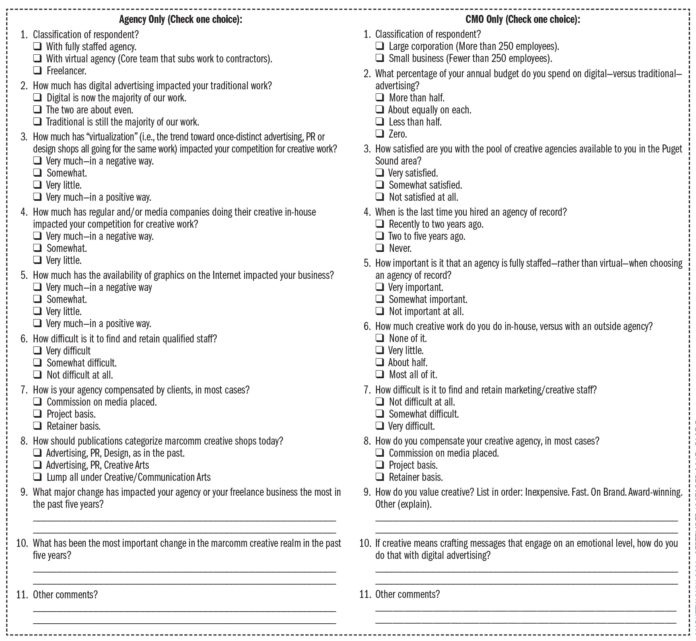By Don Morgan
There was a lot of confirmation of what most believe is happening in the local marcomm realm—from the vendor perspective—in the responses to the Marcomm Creative Survey.
And it was no surprise to get an eyeful over the clear and growing impacts of all things digital, in what has long been a traditional-advertising bastion in Seattle.
But there was a surprise or three, like the availability of Internet graphics being seen by some 40% of the respondents as having Very Little impact on their businesses—despite lots of comments to the contrary in the open-end questions.
Another was the overwhelming lead of Project-Based compensation, which left the long-time favorite—Commission on Media Placement—in the dust and a distant third behind both Project- and Retainer-Based options.
You’ll also find some interesting—and perhaps surprising—responses to the three open-end questions. Of particular note are the large number of comments about the problems posed by the growth of potential clients’ in-house capabilities.
Here’s a summary of responses to the multiple-choice and open-end questions by the 92 vendor-track participants in the online survey, conducted over the past two months by GMA Research for MARKETING:
Job classifications: Some 56% of the respondents were with a fully staffed agency, 25% were freelancers and 19% were with a virtual agency team that subs work to contractors.
Impact of digital advertising on traditional work: The growth in digital advertising is reflected in the fact that more than 41% of respondents say their work is About Evenly Divided between digital and traditional work and more than 34% say it’s now the Majority of Their Work. The remaining 24% say traditional is still the Majority of Their Work.
Impact of “virtualization” (trend toward once-distinct Ad/PR/Design shops all going for the same creative work): A 52% majority say it has impacted Somewhat, compared with more than 21% who say there has been Very Little impact. Those who feel it has impacted Very Much in a Negative Way and a Positive Way were split evenly at 13.3% apiece.
Impact of regular/media companies doing their creative work in-house: Again, the Somewhats ruled at more than 41%, with more than 34% saying Very Little and 24% saying Very Much in a Negative Way.
Impact of Internet graphics on business: As noted earlier, it’s somewhat surprising that nearly 40% said Very Little, followed by nearly 33% saying Somewhat, with another split of the Very Much in a Negative/Positive Way at 13.7% apiece.
Difficulty in finding qualified staff The Somewhats ruled again, at 53%, followed by 30% saying Not Difficult at All and 17% saying Very Difficult.
Compensation: Commission on Media Placed, the time-honored means of agency compensation, finished a distant third, at 8.6%. Project Basis was the runaway leader at 70%, followed by Retainer Basis at 21.4%.
Categorizing marcomm creative shops: The much preferred way, at nearly 57%, was to lump all under Creative/Communication Arts, compared with either Ad/PR/Design at 26% or Ad/PR/Creative Arts at 17%.
The following three open-end questions provided valuable elaboration on the multiple-choice responses:
Change that has impacted your agency the most in the past five years: The four dominant categories of comment were Digital/Internet, In-House/Virtualization Trends, Budget/Revenue issues and Time Constraints:
—Digital/Internet:
“Competition for digital dollars.”
“Crowdsourcing is making it more difficult to convince prospects of the value of hiring and paying us for our experience, wisdom and expertise.”
“Ability of the Internet to offer DIY solutions to clients.”
“Companies like VistaPrint rising in prevalence.”
“Clients’ increasing reliance on digital-only shops.”
“The proliferation of content and artwork freely available on the Internet, and the inability of clients to distinguish the good from the bad.”
“The shift to digital.”
—In-House/Virtualization Trends:
“Better, stronger in-house teams.”
“The move to in-house client staffing, based on technical (not creative) ability.”
“Other types of agencies vying for the work we do.”
“Too few work projects, due mostly to companies taking creative in-house.”
“In-house growth.”
“So many companies have formed as Ad Agencies. Yet they don’t really have the experience of knowledge to be an agency….clients have no idea what’s happening behind the scenes. I’m a 37-year-old agency and the last time I responded to an RFP, a total of 27 agencies submitted. Most were not qualified.”
“The rise in in-house creative, as well as specialty firms.”
“The move toward clients taking their work in-house.”
“Too many people doing work they’re not qualified for. For example, doing your own designing because software is so easily available.”
“Media companies, like Tegna, Sinclair and others, creating bad, and in most cases, non-creative marketing.”
“Taking work in-house.”
“Clients taking digital work in-house or to specialized agencies.”
“The need to work with corporations, rather than small business, and educate them on the unique skill sets available and how to use them.”
—Budget/Revenue Issues:
“The recession still ripples thru. Some large clients have adopted the slow-pay (90 days) virus that was prevalent in the recession. Ugh.”
“Loss of print revenues.”
“Downward price pressure, due to increased competition.”
“Lower budgets.”
“Non-consistent client budgets.”
—Time Constraints:
“The amount of time to deliver a project has shrunk. Clients need stuff really fast”
“Deadlines are faster than ever—if that’s possible.”
“Unrealistic expectations for speed in delivering work.”
“Quicker deadlines.”
Most important change in the marcomm creative realm in the past five years: Again, here’s a potpourri of informative replies, but with no particular categorization:
“Digital marketing/instant data.”
“Creative value depreciation.”
“Virtual agencies.”
“The takeover of marketing support materials by the Internet.”
“The growth and impact of social media.”
“Lines blurring among who does creative work and what the creative work looks like.”
“Creative people being hired in-house and globalization.”
“The transition from idea-based creative to return-based creative.”
“Constant demand for new content.”
“Just about anyone with a computer can say them have marcomm expertise.”
Other Comments: Perhaps this should have been called “Parting Shots”—and there were some interesting ones:
“Smaller agencies are able to compete in an arena that was dominated by a large creative staff in the past.”
“It’s difficult to be a smaller shop and earn commensurate dollars.”
“Budgets down; salaries/costs up.”
“It’s very difficult to categorize ‘ad agencies’ these days.”
“Gone are advertising’s glory days. It’s being run by bean counters.”
“Strategic creative thinking is no longer necessary, in the eyes of the short-sighted.”
“It’s unfortunate the Seattle advertising community has been so ineffective at attracting the largest in- and out-of-market clients.”
 Don Morgan is the principal of GMA Research, based in Bellevue, which has been conducting surveys in the Puget Sound area and nationally for nearly 50 years. GMA clients include leading brands in the transportation, retail, technology, tourism, health care, banking and restaurant industries. You can contact him at don@gmaresearch.com.
Don Morgan is the principal of GMA Research, based in Bellevue, which has been conducting surveys in the Puget Sound area and nationally for nearly 50 years. GMA clients include leading brands in the transportation, retail, technology, tourism, health care, banking and restaurant industries. You can contact him at don@gmaresearch.com.






